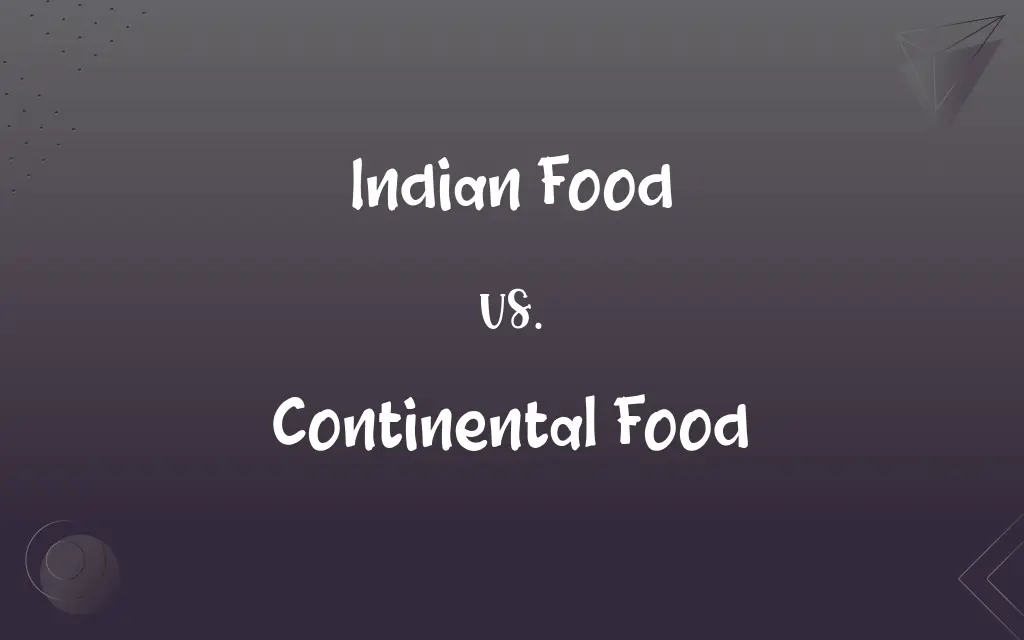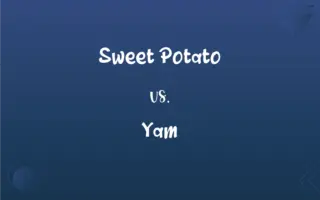Indian Food vs. Continental Food: What's the Difference?
Edited by Aimie Carlson || By Harlon Moss || Published on January 30, 2024
Indian Food is rich in spices and flavors, often featuring curries, rice, and a variety of breads. Continental Food generally refers to a style of cooking in Europe, characterized by less spice and more focus on olive oil, wine, herbs.

Key Differences
Indian food is known for its extensive use of spices and herbs, creating rich, complex flavors. Continental food, often associated with European cuisine, tends to be milder and focuses on the natural flavors of ingredients.
Traditional Indian cuisine often includes curries, rice dishes, and a variety of breads like naan and roti. Continental food includes dishes like pastas, steaks, and salads, with an emphasis on olive oil, herbs, and light sauces.
Indian cooking techniques include deep-frying, grilling, and slow-cooking, bringing out intense flavors. In contrast, continental cooking often involves baking, roasting, and grilling, aiming for subtlety and delicacy.
Indian meals are frequently accompanied by chutneys and pickles, adding to the flavor complexity. Continental cuisine often features side dishes like vegetables or potatoes, prepared simply to complement the main dish.
The use of dairy in Indian food is prominent in forms like ghee and paneer, while continental cuisine uses dairy more in the form of cheeses and cream.
ADVERTISEMENT
Comparison Chart
Spice Level
High, with a wide variety of spices
Generally milder, less spicy
Common Ingredients
Spices, rice, lentils, breads
Olive oil, herbs, meats, pasta
Cooking Techniques
Deep-frying, grilling, slow-cooking
Baking, roasting, grilling
Accompaniments
Chutneys, pickles
Vegetables, potatoes, simple sides
Dairy Use
Ghee, paneer
Cheeses, cream
ADVERTISEMENT
Indian Food and Continental Food Definitions
Indian Food
Traditional Indian meals are often accompanied by chutneys and pickles.
Mango chutney adds a sweet and tangy flavor to Indian food.
Continental Food
Continental cuisine focuses on olive oil, wine, and light herbs.
A continental food staple is the use of olive oil in salads.
Indian Food
Indian cooking techniques include deep-frying and slow-cooking.
Samosas are a delicious example of deep-fried Indian food.
Continental Food
Continental food typically refers to the milder European style of cooking.
Spaghetti carbonara is a classic dish in continental food.
Indian Food
Indian cuisine often includes a variety of breads and rice dishes.
Biryani is a popular Indian food known for its aromatic spices and rice.
Continental Food
Baking and roasting are common cooking techniques in continental cuisine.
Roasted chicken with herbs represents the simplicity of continental food.
Indian Food
Indian food is characterized by its diverse use of spices and flavors.
The curry is a classic example of flavorful Indian food.
Continental Food
Continental food often includes cheeses and cream in its recipes.
Cheese platters are a favorite in continental food culture.
Indian Food
Indian food is rich in vegetarian and meat-based dishes.
Paneer tikka showcases the vegetarian variety in Indian food.
Continental Food
Continental dishes often feature meats, pasta, and salads.
Grilled steak is a popular dish in continental food.
FAQs
What are popular Indian street foods?
Popular street foods include samosas, chaat, pav bhaji, and vada pav.
Are there vegetarian options in Indian cuisine?
Yes, Indian cuisine offers a vast array of vegetarian and vegan dishes.
What is a thali?
A thali is a platter serving various dishes in small bowls, offering a balanced mix of flavors and nutrients.
What is Indian food known for?
Indian food is renowned for its diverse flavors, vibrant colors, and use of a wide array of spices.
Is all Indian food spicy?
Not all Indian dishes are spicy; the cuisine offers a range of flavors from mild to very spicy.
What are typical ingredients in Continental food?
Common ingredients include olive oil, wine, herbs like thyme and rosemary, and various meats and cheeses.
What are some common spices in Indian cooking?
Common spices include cumin, coriander, turmeric, mustard seeds, cardamom, and garam masala.
What is a typical Indian meal?
A typical meal includes rice or bread (like naan or roti), a protein (meat or legumes), vegetables, and often a yogurt-based dish.
What is a typical Continental breakfast?
A typical Continental breakfast includes bread, pastries, fruit, cheese, and coffee or tea.
What are some popular Continental dishes?
Popular dishes include pasta, steaks, stews, soups, and various baked goods.
Is Continental cuisine vegetarian-friendly?
While meat is prevalent, there are vegetarian options like pastas, salads, and cheese-based dishes.
What defines Continental cuisine?
Continental cuisine refers to dishes from Europe, characterized by less spicy flavors and subtle seasoning.
Is Continental food less spicy than Indian food?
Yes, it generally uses fewer spices and focuses on the natural flavors of the primary ingredients.
How does Continental cuisine differ from other Western cuisines?
It's generally lighter than American cuisine and less spice-intensive than Mediterranean cuisine.
What is the difference between North and South Indian food?
North Indian food often includes creamy, tomato-based sauces and breads, while South Indian cuisine features rice, coconut, and spicier flavors.
What is a popular Indian dessert?
Popular desserts include gulab jamun, jalebi, and kheer (rice pudding).
Is Indian food healthy?
Indian cuisine can be healthy, focusing on vegetables, legumes, grains, and spices with medicinal properties.
Is Continental food healthy?
It can be healthy, focusing on whole grains, lean proteins, and fresh vegetables, but it also includes rich sauces and desserts.
What is a common cooking method in Continental food?
Baking and roasting are common, along with grilling and sautéing.
What are some typical Continental desserts?
Common desserts include pastries, tarts, and custards like crème brûlée.
About Author
Written by
Harlon MossHarlon is a seasoned quality moderator and accomplished content writer for Difference Wiki. An alumnus of the prestigious University of California, he earned his degree in Computer Science. Leveraging his academic background, Harlon brings a meticulous and informed perspective to his work, ensuring content accuracy and excellence.
Edited by
Aimie CarlsonAimie Carlson, holding a master's degree in English literature, is a fervent English language enthusiast. She lends her writing talents to Difference Wiki, a prominent website that specializes in comparisons, offering readers insightful analyses that both captivate and inform.































































